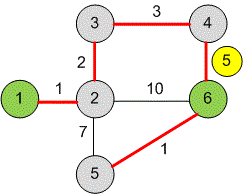Redaksiya
Sort the roads (edges of the graph) in ascending order of danger. To solve the problem, we'll use a disjoint-set (union-find) data structure. Initially, we form sets, each containing one vertex. Iterate over the edges in ascending order of danger. For each edge , merge the sets containing vertices and . Once vertices and belong to the same set, the algorithm terminates. At that point, a path from vertex to vertex will exist, and the danger of the roads on this path will not exceed the danger of the last edge considered.
Thus, if after processing edge , the representatives of vertices and coincide, the danger of the safest route will be equal to the danger of road .
Example
In the first test case, the danger of the safest route is .

Consider the second test case.

The edges are processed in ascending order of their danger. Once an edge with a danger of is processed, vertices and will be connected, and the algorithm will terminate.
Algorithm implementation
Declare an array , used by the disjoint-set system. The edges of the graph will be stored in array .
#define MAX 1000001
int mas[MAX];
struct Edge
{
int x, y, danger;
} e[MAX];The Repr function finds the representative of the set containing vertex . To avoid a Time Limit verdict, a heuristic is used: if the representative of vertex is , then should be set to .
int Repr(int n)
{
if (n == mas[n]) return n;
return mas[n] = Repr(mas[n]);
}The Union function merges the sets containing vertices and .
int Union(int x,int y)
{
int x1 = Repr(x),y1 = Repr(y);
mas[x1] = y1;
return (x1 != y1);
}Declare a comparator lt for comparing edges. The roads are sorted in ascending order of their danger.
int lt(Edge a, Edge b)
{
return (a.danger < b.danger);
}The main part of the program. Read the number of cities and roads .
scanf("%d %d",&n,&m);Initialize the array .
for(i = 1; i <= n; i++) mas[i] = i;
Read the edges of the graph into the array .
for(i = 0; i < m; i++)
scanf("%d %d %d",&e[i].x,&e[i].y,&e[i].danger);Sort the edges in ascending order of danger.
sort(e,e+m,lt);
Iterate through the edges, starting from the least dangerous one. Merge the sets containing their vertices. Once vertices and are in the same set ( becomes equal to ), the safest path will be found. Its danger will be equal to the danger of the last processed edge, that is, .
for(i = 0; i < m; i++)
{
Union(e[i].x,e[i].y);
if (Repr(1) == Repr(n)) break;
}Print the answer.
printf("%d\n",e[i].danger);Java implementation
import java.util.*;
class Edge
{
int x, y, danger;
Edge (int x, int y, int danger)
{
this.x = x;
this.y = y;
this.danger = danger;
}
};
public class Main
{
static int mas[], size[];
static int Repr(int n)
{
if (n == mas[n]) return n;
return mas[n] = Repr(mas[n]);
}
static boolean Union(int x,int y)
{
x = Repr(x); y = Repr(y);
if(x == y) return false;
if (size[x] < size[y])
{
int temp = x; x = y; y = temp;
}
mas[y] = x;
size[x] += size[y];
return true;
}
public static class MyFun implements Comparator<Edge>
{
public int compare(Edge a, Edge b)
{
return a.danger - b.danger;
}
}
public static void main(String[] args)
{
Scanner con = new Scanner(System.in);
int n = con.nextInt();
int m = con.nextInt();
mas = new int[n+1];
size = new int[n+1];
for(int i = 1; i <= n; i++)
{
mas[i] = i;
size[i] = 1;
}
Vector<Edge> v = new Vector<Edge>();
for(int i = 0; i < m; i++)
{
int x = con.nextInt();
int y = con.nextInt();
int dust = con.nextInt();
v.add(new Edge(x,y,dist));
}
Collections.sort(v, new MyFun());
int index = 0;
for(int i = 0; i < m; i++)
{
Union(v.get(i).x,v.get(i).y);
if (Repr(1) == Repr(n))
{
index = i;
break;
}
}
System.out.println(v.get(index).danger);
con.close();
}
} Python implementation
Declare the structure for an edge.
class Edge:
def __init__(self, x, y, danger):
self.x = x
self.y = y
self.danger = dangerThe Repr function finds the representative of the set containing vertex . To avoid a Time Limit verdict, a heuristic is used: if the representative of vertex is , then should be set to .
def Repr(n):
if n == mas[n]:
return n
mas[n] = Repr(mas[n])
return mas[n]The Union function merges the sets containing vertices and .
def Union(x, y): x1 = Repr(x) y1 = Repr(y) mas[x1] = y1 return x1 != y1
The main part of the program. Read the number of cities and roads .
n, m = map(int, input().split())
Initialize the list , used by the disjoint-set system.
mas = [i for i in range(n + 1)]
Read the edges of the graph into the list .
e = [] for i in range(m): x, y, danger = map(int, input().split()) e.append(Edge(x, y, danger))
Sort the edges in ascending order of danger.
e.sort(key=lambda x: x.danger)
Iterate through the edges, starting from the least dangerous one. Merge the sets containing their vertices. Once vertices and are in the same set ( becomes equal to ), the safest path will be found. Its danger will be equal to the danger of the last processed edge, that is, .
for i in range(m):
Union(e[i].x, e[i].y)
if Repr(1) == Repr(n):
breakPrint the answer.
print(e[i].danger)